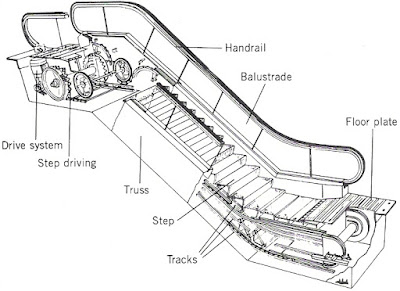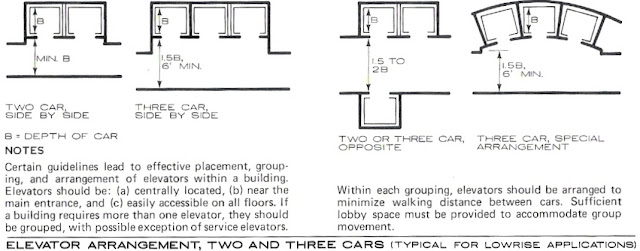PAUL HAY Capital Projects
Conveyance Systems
Author: Paul Hay
e-mail: paul.hay@phcjam.com
profile: www.linkedin.com/in/phcjam
1.0 MECHANICAL DEVICES MOVE PEOPLE & FREIGHT
1.1_ Moving Walks and ramps are used to (a) assist in walking long distances, (b) transport large and bulky objects, and (c) reduce congestion:
1.1.1 Inclines up to 15E can be provided;
1.1.2 Maximum allowable speeds depend on the inclination and design approaches.
1.2 Pneumatic tubes transport cylinders containing paperwork, money, etc. from one end of a tube to another:
1.2.1 Sizes range from 50 mm diameter to 150 mm x 450 mm (for x-rays);
1.2.2 Air pressure propels the cylinders through the tubes; and
1.2.3 Complex systems use computers to deliver cylinders to pre-selected locations along the tube.
1.3 Endless belt conveyors carry paperwork horizontally in packs or vertically in slots.
Figure 1: Conveyor System
[Source:- AIA Architectural Graphics Standards] 1.4.1 Tray systems automatically transport trays via moving carriers between dispatch cut-outs at intervals along a chain;
1.4.2 Dumbwaiters use ropes and pulleys to transport items on cars or platforms through a vertical shaft:
1.4.2.1 They can be manual or automatic;
1.4.2.2 Manual operation is limited to two floors;
1.4.2.3 They are used in restaurants, libraries, and offices;
1.4.2.4 Vertical shafts should be installed adjacent to other vertical shafts.
1.5 An escalator is a mechanical staircase with moving treads which transport standing pedestrians.
1.6 Elevators can be electric traction or hydraulic.
2.0 ESCALATORS ARE MORE EFFICIENT THAN ELEVATORS
 |
Fig. 2: Escalator[Source:- Mechanical & Electrical Equipment for Buildings] |
2.1 Escalators occupy a fifth of the space elevators require to transport comparable amounts of people.
2.2 A sixth less escalators are required to move comparable amounts of people.
2.3 Escalators are typically 800 mm or 1,000 mm wide between handrails.
Figure 3: Escalator in crisscross arrangement
[Source:- Mechanical & Electrical Equipment in Buildings]2.4 They are usually installed in pairs:
2.4.1 They can be installed in parallel or criss-cross;
2.4.2 Treads and handrails are inclined at 30E from the lower floor;
2.4.3 50 m2 space should be provided at either end of the escalator to facilitate easy mounting and dismounting.
Figure 4: Escalator in parallel arrangement
[Source:- Mechanical & Electrical Equipment in Buildings]2.5 Escalators can serve up to 5 storeys.
2.6 Escalators are constructed as a steel-trussed framework:
2.6.1 Motor-driven sprocket wheels at each end revolve to form two chains which pull a conveyor-belt of treads;
2.6.2 Sprocket wheels and chains also move the handrails;
2.6.3 Automatic roller shutters can be deployed over tops of horizontal wellway openings for fire protection on any floor:
2.6.3.1 Sprinklers can be installed on the soffit of the escalators and on the ceiling immediately surrounding the wellway;
2.6.3.2 Blowers on the roof can force fresh air through floor openings; and
2.6.3.3Extractors can exhaust indoor air above the roof.
Figure 5: Elevator Lobbies
[Source:- AIA Architectural Graphics Standards]3.1 Double-decker cabs require escalators to transport people from the ground floor to the upper floor.
3.2 Sky lobbies require the building to be divided into 2 or 3 zones:
3.2.1 Each zone has independent elevator systems using a common shaft;
3.2.2 Express elevators facilitate movement between lobby zones.
3.3 Clear opening for commercial installations is typically 1,050 mm.
3.4 Clear opening up to 1,500 mm wide are available for service elevators and hospitals.
3.5 Centre-opening doors provide the fastest closing speeds.
3.6 Emergency power is recommended as brakes hold cabs stationery during power outages or brown-outs:
3.6.1 Hydraulic elevators and small traction cabs can be lowered manually; but
Figure 6: Traction & Hydraulic Elevators
[Source:- AIA Architectural Graphic Standards]4.0 TRACTION ELEVATORS ARE MORE ECONOMICAL TO OPERATE
4.1 Mechanical components include (a) grooved sheave, (b) electric motor with brakes, (c) auxiliary equipment, (d) elevator shaft, (e) guide rails, (f) cab, (g) hoist wire ropes, (h) counter-weight, and (i) safety springs or buffers.
4.2 The sheave, motor and auxiliary equipment are located in a machine room:
4.2.1 The machine room is typically located over the shaft but the motor can be located in the basement; but
4.2.2 Basement location increases power consumption, loading on overhead supports, and wear on ropes;
4.2.3 The room is approximately twice the size of the shaft;
4.2.4 1 2 additional storeys is required above the top of the beam supporting the elevator shaft.
4.3 Guide rails, cabs, counter-weight, and spring/buffers are installed in the shaft:
4.3.1 Guide rails are placed on each side of the cab;
4.3.2 The hoist wire is attached to the top of the cab at one end, wraps around the sheave, and is attached to the counter-weight at the other end.
5.0 HYDRAULIC ELEVATORS ARE INSTALLED IN LOW-RISE BUILDINGS
5.1 Buildings are typically no higher than 18 m.
5.2 Mechanical components include (a) reservoir, (b) pump, (c) elevator shaft, (d) guide-rails, (e) cab, (f) plunger, and (g) safety springs or buffers.
5.3 The cab is supported by the plunger within the elevator shaft.
5.4 Oil from a reservoir is pumped into the plunger to raise the cab.
5.5 Oil is released from the plunger to lower the cab.
5.6 Plunger may require a hole below the basement floor to a depth equivalent to the travel of the elevator.
FURTHER READING
Mechanical and Electrical Equipment for Buildings, 8th edition, Benjamin Stein, John S. Reynolds, John Wiley & Sons Inc., USA, 1992
Construction Materials & Processes, Don G. Watson, McGrawHill Book Co., USA, 1978;
Architectural Handbook, Alfred M. Kemper, John Wiley & Sons Inc., USA, 1979






how about other arrangement of escalator?
ReplyDeleteCan you suggest a site where this can be found? Others might benefit from it.
ReplyDeleteThis blog is very useful in informative. If someone want to know about hydraulic elevator and its benefit then Essem Engineers is your stop.
ReplyDeleteThis blog is very useful in informative. Jaimini Elevators are the prominent and leading hospital lift manufacturer in Delhi.
ReplyDeletehospital lift service providers in delhi
Really nice information, i agree to the point that escalators are more efficient than elevators, check the only escalator manufacturer in india.
ReplyDeleteThis comment has been removed by the author.
ReplyDeletenice post
ReplyDeleteglass lift service providers in delhi
residential elevator service providers in delhi
Great Information About Elevators and Esclators And You Can contact To Installation. You Can Also Visit to Know More About
ReplyDeleteWow. its amazing article. Thank you for the sharing informative post.
ReplyDeleteHome Lifts in Chennai
Residential Lifts in Chennai
You got a really useful blog I have been here reading for about an hour. Please visit us
ReplyDeleteHydraulic Goods Lift Manufacturers in Bangalore | Goods Lift Manufacturers in Bangalore
Nice blog..! I really loved reading through this article... Thanks for sharing such an amazing post with us and keep blogging.Scissor Lift Manufacturer in Bangalore | Goods Lift Manufacturers in Bangalore
ReplyDeleteThis comment has been removed by a blog administrator.
ReplyDeleteIt was so informative and useful on. I found some very useful topics from this blog. Elevators have an important role in our daily life. without residential elevators like hydraulic lifts nothing can be good as like now.
ReplyDelete